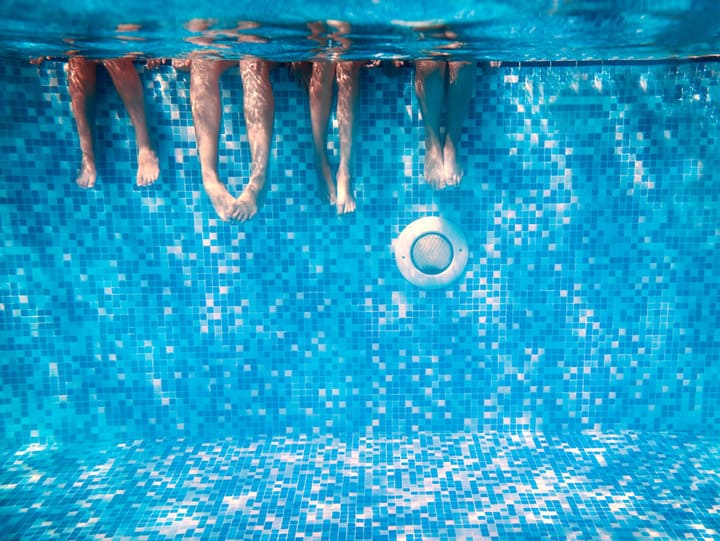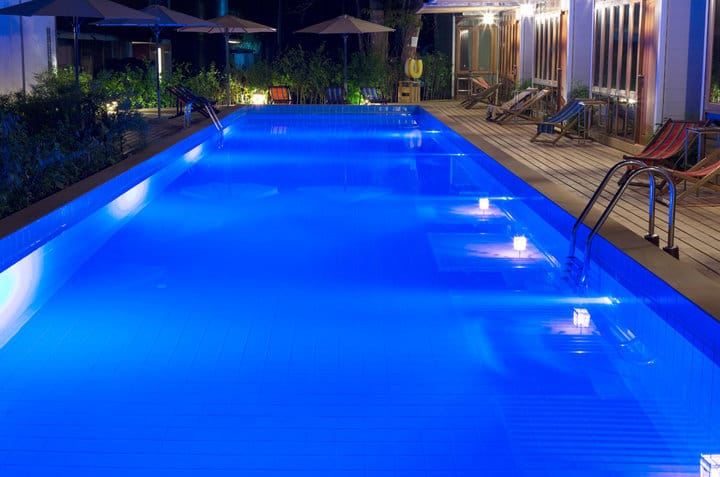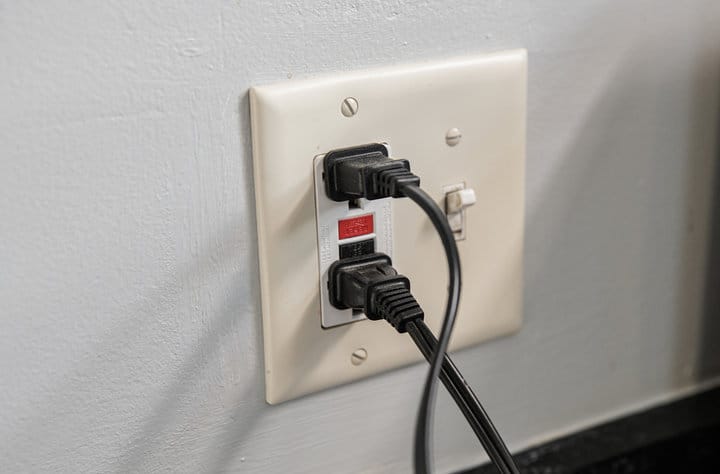Whether you’re setting up your pool lights for the first time or carrying out a renovation on your existing pool, one question you may have is about the requirement for a ground fault circuit interrupter (GFCI).
A GFCI is a safety device that monitors the electrical current in the circuit and cuts out the power when it detects a problem to prevent serious harm.
But are they required for low-voltage lights?
The National Electrical Code states that only pool lights requiring 15 volts or more need to be GFCI protected. Most low-voltage lights are 12-14 volts, so it isn’t necessary – but it is still helpful to use a GFCI outlet if possible.
To explore this topic in a little more detail, I’ll take you through:
- Whether low voltage lighting is safe around a pool
- Whether pool lights need to be GFCI protected
- Reasons why a pool light might trip a GFCI
Is Low Voltage Lighting Safe Around The Pool?

Some assume that low-voltage lighting is ‘safe’; therefore, you don’t need to worry about water splashes around it.
But that’s not really true.
Low-voltage lighting is safer than mains-voltage lighting, but it’s still not ‘safe.’
The National Electrical Code – specifically Article 411.4(2) – states that you can’t have low-voltage lighting systems for gardens within 10 feet of the nearest edge of water.
So that’s ponds, fountains, and swimming pools that you need to consider.
However, there are exceptions under Article 680.
This covers pools and spas and means that as long as you buy low-voltage lighting designed for use in a pool, you can use it.
A low-voltage light, if not properly installed or if it develops a fault, can still electrocute you.
It’s not likely to be fatal, but it can still be dangerous or, at the very least painful.
Around a swimming pool, do you really want to risk injury that could then increase your chance of drowning?
So treat low voltage lighting with the same respect you would treat mains voltage lights.
Make sure general low-voltage lights are 10 feet or more from your pool and that any pool lights you’re installing closer to the pool are designed for that use.
Do Pool Lights Require GFCI?

It’s a misconception that all swimming pool lights must be plugged into an outlet (via the transformer) with GFCI protection.
In fact, Article 680-20a1 of the National Electrical Code states that only pool light fixtures of 15 volts or more must be GFCI-protected.
Since most low-voltage pool lights are 12 volts, you don’t need to install a GFCI outlet if you don’t already have one.
However, just because you don’t have to doesn’t mean you shouldn’t.
Low-voltage pool lights are much safer than mains voltage lights, but having GFCI outlets can still protect you.
It can also prevent or minimize damage to your lights if there is a short.
There is no harm in exceeding the minimum electrical code.
Why Does The Pool Light Keep Tripping GFCI?

To find out why your pool light keeps tripping the GFCI, it helps to understand how they work in the first place.
A GFCI outlet works by monitoring the current levels of both the live and neutral wires.
Remember that current travels to your pool lights through the live wire, and that same current returns through neutral.
GFCI outlets check to ensure that the current is approximately the same on both wires (there’s a very fine margin of allowance).
When the returning current has dropped, that’s when it knows there’s a problem on the line somewhere, and it cuts the power.
So, what could be causing pool lights to behave in this way?
Unsurprisingly, the answer is usually ‘water,’ although more specifically, it could be one of two things.
Either water has got into the pool light fixture itself, or you’ve got a leak in the waterproof wire conduit.
The conduit shouldn’t just wear down randomly, so the most likely problem is water in the light fixture – check for any signs of water in the light.
You might not notice water building up inside, but check for bubbles forming around the fixture – that’s a sign that air is escaping, which means water is getting in.
If your low-voltage light has changeable light bulbs, you’ll want to remove the fixture, dry it out, and probably replace the bulb – but you’ll definitely need to replace the gasket, which provides the watertight seal.
You must replace the entire fixture if it’s an enclosed, sealed light.
These fixes assume the problem is with one of the lights, but it could be a problem with the transformer or the GFCI itself.
You could test by disconnecting each pool light and turning the power back on.
If the GFCI only trips when a specific light is connected, you know that’s the issue.
If it trips, regardless of which lights are connected, it’s the transformer or GFCI.
The simple test would then be to unplug the transformer from the outlet and plug something else in. Then, if the GFCI still trips, you know it’s faulty.
You’d need to replace the outlet itself.
If it doesn’t, you’ve got a faulty transformer and probably need to replace it too.
There are various reasons why lighting transformers fail, but they aren’t devices you can normally repair.
Final Words
If you’re installing low-voltage pool lights that run on 12-14 volts, as most modern options will do (including LEDs), then installing a GFCI outlet is optional – you aren’t legally required to have one.
But it will help, so it’s worth doing it if you want to protect yourself or your lighting.
It is still possible for low-voltage lighting to electrocute you, and a GFCI can help prevent that.
Have you got your pool lighting installed on a circuit with GFCI, and have you ever had problems with it tripping regularly?

